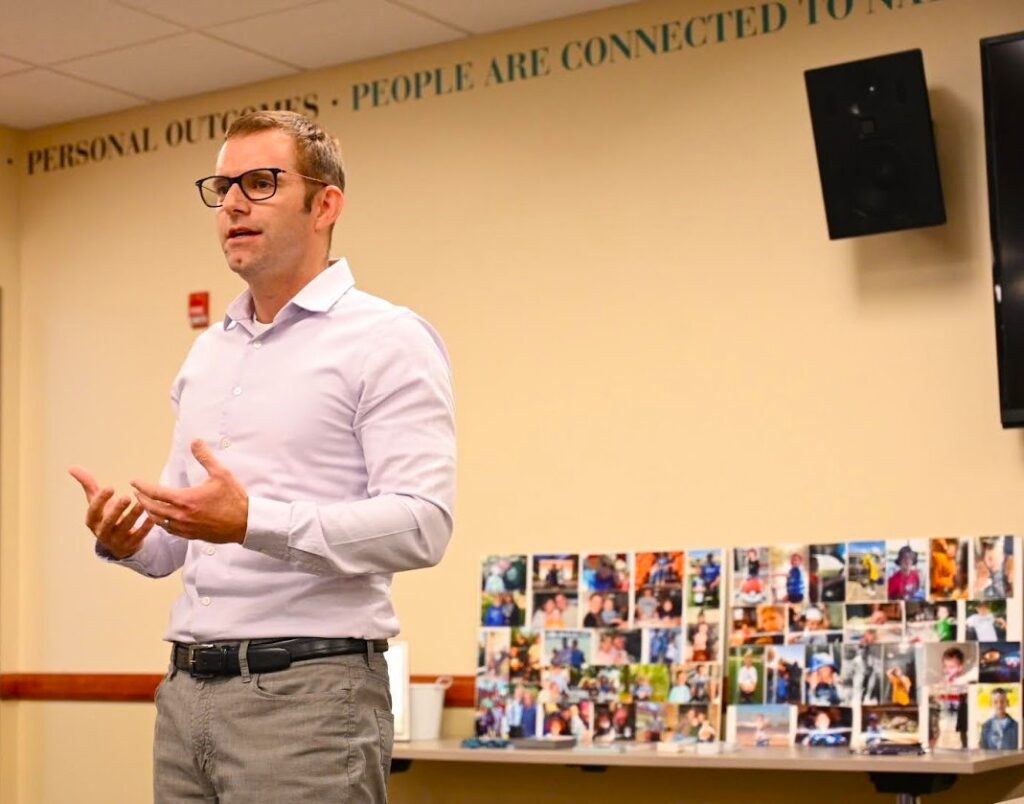Suicide Prevention: Hope for Those Who Need Healing

By Stephanie Irvine
Shelly Lewis of Manhattan said her 15-year-old son Jackson was a typical teenager, gently rebelling during COVID.
Then, he unexpectedly committed suicide.
Lewis shared her story as a panelist on the October 22 New Lenox Safe Communities suicide prevention program, “A Pathway to Hope and Healing.”
The suicide prevention program is an annual event that has been held for the past eight years. It included a resource fair with 13 vendors, followed by a four-person panel discussion composed of clinical professionals and speakers who have lived through the suicide of a loved one.
Lewis explained how it affected herself and her family, including the guilt and despair that they felt, especially her husband, because their son had used his gun. She remained poised while retelling the story of how he was found and how they had to make the gut-wrenching decision to end life support.
Lewis attributed therapy and attending grief counseling to helping her and her family heal and continue to heal. She volunteers her time to suicide prevention and awareness advocacy and established a foundation in honor of her son.
Clinician Marie Kress, LCPC, of The Manhattan Wellness Center, spoke about the connection between addiction and suicide. She explained that addiction is a comorbidity of suicide. During her presentation, she explained that often, people are under the influence when they attempt or complete a suicide attempt.
Pearl Casurella of Ottawa also spoke about her personal experience and how it affected herself and her four children. Her husband battled suicidal thoughts and addiction before carrying out suicide not long after they had divorced — the day before their son’s birthday.
Casurella’s shared with the large audience how devastating it was for her and her family, emotionally and financially, and how they ended up going from living in a dilapidated farmhouse with inadequate heat, trying to find the means to survive, to thriving and living well.
She explained that she signed up for every list there is and urged people to take advantage of all the help that exists. Her message was that there is hope after going through incredible tragedy.
Gloria Bodnar, a nurse from New Lenox who is an individual member of the Safe Communities suicide task force coalition. She came to listen to the panel.
“I’ve worked in intensive care, and have seen a lot of suicide attempts and completions come in,” she said. “So, I know what it does not only to the patient but to the families and how devastating that can be.
“Anything that I can do to have resources or have things to give out to people so that they know that there’s people out there who can help them. They’re not alone. “It’s important to take the stigma off of it so people feel comfortable asking for help and getting help.”
First-time attendee Isabel Lopez of Burbank said she attended to get more information.
“For me it’s personal. At a young age, my best friend committed suicide when she was 16. Recently, a good friend of mine — her husband — committed suicide.”
Lopez added that she works with Chicago Public Schools and wanted to get more resources for herself, family and friends.
“Not a lot of people, especially minorities, are aware of the resources available,” Lopez said.
The event concluded with an exercise and impassioned speech from panelist Dr. Michael Mecozzi, who explained how and why hanging on to negative events and thoughts is so easy, and, because of that, why people experience more depression and anxiety, resulting in feeling that it’s their fault, creating a stigma.
Mecozzi’s message was “HOPE,” an acronym that people can use to combat negative thoughts and experiences. “HOPE stands for help is available, opening up to connect with resources, pursuing purpose and values, and engagement with resources.
“The idea behind it is at the end of the event, we want to leave these people with hope. We want to leave them with the idea that there’s help out there,” Safe Communities Coordinator Dan Martin said.
“There’s resources available, which is why in part we do the resource fair, why we have clinicians on the panel to talk about why some of these things occur and identify what the warning signs are, and if you do suffer a loss, what are some of the coping mechanisms to get through the loss,” Martin explained.
Those interested in joining the Safe Communities organization and any of its taskforces, whether as an individual or organization, can reach out to Dan Martin at [email protected].
Stephanie Irvine is a freelance reporter.

Panelists at the Suicide Prevention program included, from left, Marie Kress, of The Manhattan Wellness Center, Pearl Casurella, who shared how her ex-husband committed suicide on her son’s birthday, and Shelly Lewis, who lost her 15-year-old son to suicide.